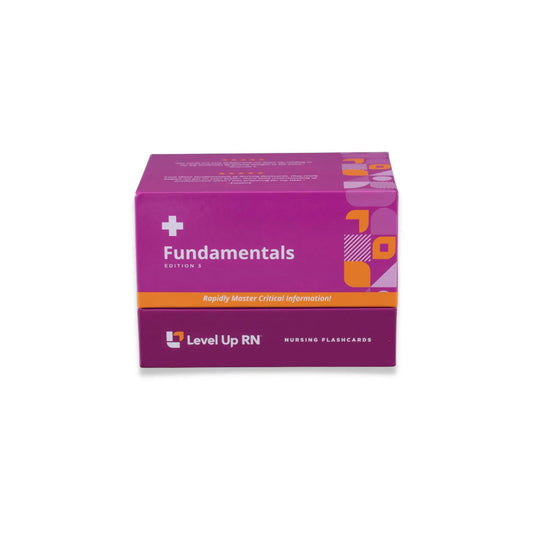Fundamentals - Community Health, part 4: Vulnerable Populations and Violence
Updated: Ellis ParkerVulnerable populations including examples of what unique health risks different groups face. We then transition into violence in the community covering risk factors for violence, specific violent acts, and the impact violence has on an individual.
Full Transcript: Fundamentals - Community Health, part 4: Vulnerable Populations and Violence
Full Transcript: Fundamentals - Community Health, part 4: Vulnerable Populations and Violence
Hi. I'm Ellis with Level Up RN. In this video, we'll be chatting about vulnerable populations as well as violence in the community. These cards are found in our community health section of our fundamentals of nursing card deck. So if you have that deck, you can grab these cards, and then you can see which text is bold and red on the back of them. If you don't have that deck, check us out at leveluprn.com. After we chat about the content, make sure you sit tight because I do have a couple of questions to check your knowledge. We're going to start with vulnerable populations. Vulnerable populations are groups of people that have a higher risk of poor health outcomes due to societal barriers or a lack of resources or even just a physical limitation. On this card, we have a couple of examples of vulnerable populations. Our first example vulnerable population is migrant workers. So migrant workers have a higher risk of work-related injury and that could be physical injuries, but it's also because of exposure. They are more prone to being exposed to pesticides, chemicals, and even just the sun, and that increases the risk for skin cancers. Migrant workers also experience higher risks of dermatitis as well as communicable diseases like tuberculosis, and because of a lack of preventative care, they're more likely to have dental problems.
Our next vulnerable population are the unhoused or people who are experiencing homelessness, and these individuals are more likely to have trauma-related injuries as well as skin disorders and skin lesions often caused by insect bites or infestations like scabies and lice. They're more likely to experience STIs, substance abuse, and mental illnesses. And they are also more exposed to communicable diseases and experience higher levels of dental problems due to the lack of preventative care. Veterans have higher risks of mental health disorders, including posttraumatic stress, depression, substance abuse, and suicide. They also have higher incidences of traumatic brain injuries, amputations, and chronic pain. The LGBTQ+ population is at higher risk of developing substance use and abuse disorders as well as suicide, being unhoused or experiencing homelessness, other mental health disorders, and victimization. The final group covered on this card are people with disabilities. They're more likely to have comorbidity issues and chronic diseases like diabetes or obesity or hypertension. And they're also more likely to experience a lack of preventative care as well as partake in unhealthy coping mechanisms like smoking.
We're going to transition into violence in the community. And community risk factors for experiencing violence include poverty, unemployment, mental health disorders, substance abuse, access to firearms, and media influence. Victim risk factors will change based on the type of violence. So risk factors for experiencing homicide are going to include being male, African American, and in the young adulthood age category. Risk factors for experiencing suicide are also being male, being Native American, and being actually over the age of 75, which I think surprises some people, but that is the population that experiences the highest incidence of suicide. And risk factors for experiencing sexual assault are being females and already experiencing some type of intimate partner violence.
So the effects of violence and the impact of violence on an individual is, of course, going to vary, but witnessing and being the victim of violent acts may lead to long-term poor health outcomes that include behavioral changes and mental health issues. Individuals that are exposed to violence at any age are also more likely to experience or perpetrate, intimate partner violence. Ideally, we prevent violence before it happens, so the key here is prevention, which often comes down to education. Education can be things like parenting classes, life skills classes, as well as anger management. These also are going to include things like mentoring and peer programs to help support people in making their best decisions and screening for abuse during every healthcare visit. That's going to wrap up the content for this video, so hang tight, and we'll check your knowledge.
Describe what a vulnerable population is. A vulnerable population is a group of people that have higher risks of poor health outcomes due to societal barriers, a lack of resources, and/or physical limitations. Name at least three health-related risks faced by individuals who are experiencing homelessness or being unhoused. These individuals are more likely to experience trauma-related injuries as well as skin issues and skin lesions, perhaps due to insects or infestations like lice and scabies. They also have higher incidences of STIs, substance abuse, mental health disorders, communicable diseases, and dental problems. What effect may occur due to being the victim or witness of violence? Witnessing or being a victim of violence may increase the risk for long-term poor health outcomes related to behavior or mental health. It also increases the risk of experiencing or perpetrating intimate partner violence. Thank you so much for joining me in studying community health. In our next video, I'm going to be chatting about subsidized health insurances.


